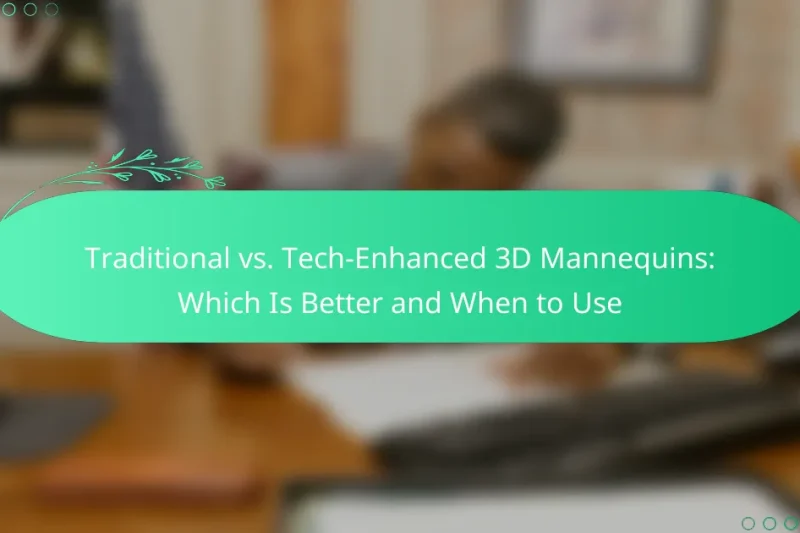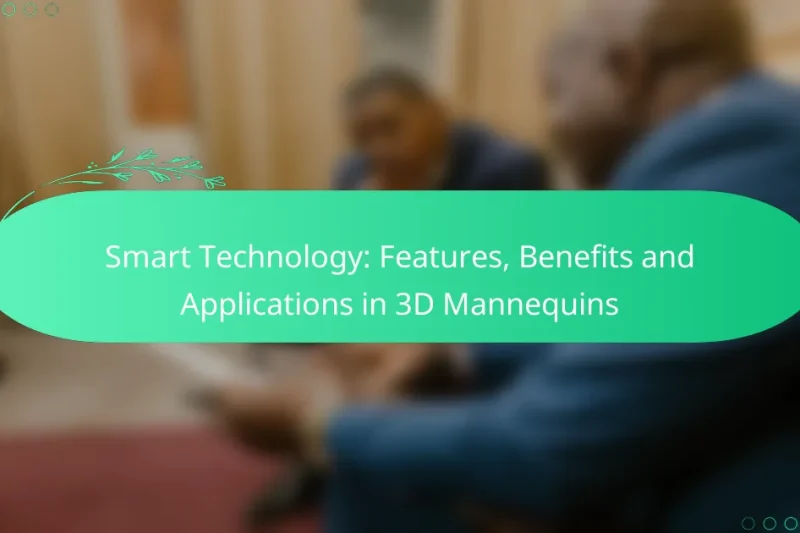3D mannequins are revolutionizing the e-commerce landscape by offering realistic product representations that enhance user experience. … 3D Mannequins: E-Commerce Integration and User ExperienceRead more
3D Mannequin Technology Integration
3D mannequin technology integration revolutionizes the retail landscape by enhancing customer engagement and driving sales. By leveraging lifelike digital models, businesses can create immersive shopping experiences that foster deeper product understanding and heightened consumer interest. A successful implementation requires careful selection of technology providers and a structured approach to integration, ensuring alignment with organizational goals and existing systems.
Traditional vs. Tech-Enhanced 3D Mannequins: Which Is Better and When to Use
When it comes to showcasing products in retail, the choice between traditional and tech-enhanced 3D mannequins … Traditional vs. Tech-Enhanced 3D Mannequins: Which Is Better and When to UseRead more
3D Mannequins: Choosing the Right Technology Features and Enhancements
In today’s retail landscape, 3D mannequins have become essential tools for enhancing customer engagement and improving … 3D Mannequins: Choosing the Right Technology Features and EnhancementsRead more
Future Trends: Innovations and Advancements in 3D Mannequin Design
The future of 3D mannequin design is marked by groundbreaking innovations that prioritize interactivity, sustainability, and … Future Trends: Innovations and Advancements in 3D Mannequin DesignRead more
Technology Integration: Successful Case Studies in 3D Mannequins
Technology integration in 3D mannequins has transformed the retail landscape by enhancing customer experiences and optimizing … Technology Integration: Successful Case Studies in 3D MannequinsRead more
Smart Technology: Features, Benefits and Applications in 3D Mannequins
Smart technology in 3D mannequins revolutionizes the retail landscape by incorporating advanced features that enhance interactivity … Smart Technology: Features, Benefits and Applications in 3D MannequinsRead more
Augmented Reality: Enhanced Shopping Experiences and Customer Engagement
Augmented reality (AR) is revolutionizing the shopping experience by enabling customers to visualize products in their … Augmented Reality: Enhanced Shopping Experiences and Customer EngagementRead more
What are the benefits of 3D mannequin technology integration?
3D mannequin technology integration offers significant advantages for businesses, enhancing customer interaction and improving sales outcomes. By utilizing realistic digital representations, companies can create immersive shopping experiences that lead to better product understanding and increased consumer interest.
Enhanced customer engagement
3D mannequins provide a dynamic way for customers to interact with products, allowing them to visualize items in a more lifelike manner. This engagement can lead to longer browsing times and increased likelihood of purchase. For instance, virtual fitting rooms enable customers to see how clothing fits on a 3D model that resembles their own body type.
Improved sales conversion rates
Integrating 3D mannequins can significantly boost sales conversion rates by offering a more compelling product presentation. Studies suggest that customers are more likely to make a purchase when they can see a product in a realistic context. For example, retailers that use 3D models often report conversion increases of 20-30% compared to traditional images.
Cost-effective inventory management
3D mannequin technology can streamline inventory management by reducing the need for physical samples. Businesses can showcase a wide range of products without the associated costs of manufacturing and storing physical items. This approach not only saves money but also allows for quicker updates to product lines as trends change.
Realistic product visualization
With 3D mannequins, customers can view products from multiple angles and in various settings, enhancing their understanding of the item. This realistic visualization helps in reducing product returns, as customers have a clearer expectation of what they are purchasing. For example, furniture retailers can use 3D models to show how items fit within different room layouts.
Streamlined design processes
3D mannequin technology can simplify the design process for retailers by allowing for rapid prototyping and adjustments. Designers can create and modify digital models quickly, reducing the time from concept to market. This agility is crucial in fast-paced industries where trends can change rapidly, enabling businesses to stay competitive.
How to choose a 3D mannequin technology provider?
Choosing a 3D mannequin technology provider involves evaluating their technology compatibility, customer support, pricing models, and real-world effectiveness. A well-rounded decision will ensure that the chosen provider meets your specific needs and integrates seamlessly with your existing systems.
Evaluate technology compatibility
Assessing technology compatibility is crucial for a successful integration of 3D mannequin solutions. Ensure that the provider’s technology aligns with your current software and hardware systems, including compatibility with platforms like e-commerce sites or design software.
Check for support of common file formats and APIs that facilitate data exchange. This will help avoid potential integration issues down the line.
Assess customer support options
Reliable customer support is essential when implementing 3D mannequin technology. Look for providers that offer multiple support channels, such as phone, email, and live chat, to address any issues promptly.
Consider the availability of support during your operational hours. A provider with 24/7 support may be beneficial, especially if you operate in different time zones or have urgent needs.
Compare pricing models
Pricing models for 3D mannequin technology can vary significantly among providers. Some may offer subscription-based pricing, while others might charge a one-time fee or a combination of both.
Evaluate what is included in the pricing, such as updates, support, and additional features. Comparing these aspects can help you determine the best value for your investment.
Review case studies and testimonials
Case studies and testimonials provide insight into a provider’s effectiveness and reliability. Look for examples from businesses similar to yours to understand how the technology has performed in real-world scenarios.
Pay attention to specific metrics or improvements reported by previous clients, such as increased sales or enhanced user engagement. This information can guide your decision-making process and help set realistic expectations.
What are the integration steps for 3D mannequin technology?
The integration of 3D mannequin technology involves a series of structured steps to ensure successful implementation. These steps guide organizations through defining objectives, selecting appropriate tools, executing the integration, and training personnel effectively.
Step 1: Define project scope
Defining the project scope is crucial as it sets the foundation for the entire integration process. Identify the specific goals, such as improving customer engagement or enhancing product visualization, and determine the resources available, including budget and timeline.
Engage stakeholders to gather input on expectations and requirements. This collaborative approach helps to clarify the project’s objectives and ensures alignment across all departments involved.
Step 2: Select software and hardware
Choosing the right software and hardware is essential for effective 3D mannequin integration. Evaluate various software options based on compatibility with existing systems, user-friendliness, and specific features that meet your project needs.
For hardware, consider the performance specifications required for rendering 3D models efficiently. This may include powerful graphics cards, high-resolution displays, and sufficient storage capacity. Budget for both initial costs and ongoing maintenance.
Step 3: Implement and test
Implementation involves setting up the selected software and hardware, followed by rigorous testing to ensure functionality. Create a detailed implementation plan that includes timelines and responsibilities for each team member.
During testing, focus on usability and performance metrics. Gather feedback from users to identify any issues or areas for improvement. This iterative process helps refine the system before full deployment.
Step 4: Train staff
Training staff is a vital step to ensure successful adoption of the new technology. Develop a comprehensive training program that covers both the technical aspects of the software and best practices for using 3D mannequins effectively.
Consider offering hands-on workshops and creating user manuals or online resources. Encourage ongoing support and feedback to address any challenges that staff may encounter as they adapt to the new system.
What are the costs associated with 3D mannequin technology?
The costs associated with 3D mannequin technology can vary significantly based on several factors, including initial setup, ongoing maintenance, and licensing fees for software. Understanding these costs is crucial for businesses considering this technology for their operations.
Initial setup costs
Initial setup costs for 3D mannequin technology typically include hardware, software, and any necessary infrastructure. Businesses can expect to invest anywhere from a few thousand to tens of thousands of dollars, depending on the complexity of the system and the quality of the 3D models.
Factors influencing these costs include the choice of 3D scanning equipment, the level of customization required, and the integration with existing systems. For example, high-end scanning devices may offer better accuracy but at a higher price point.
Ongoing maintenance expenses
Ongoing maintenance expenses for 3D mannequin technology include software updates, hardware servicing, and potential repairs. Businesses should budget for regular maintenance to ensure the technology remains functional and up-to-date.
These costs can range from hundreds to thousands of dollars annually, depending on the scale of the operation and the complexity of the systems in use. It’s advisable to set aside a percentage of the initial investment each year for maintenance to avoid unexpected expenses.
Licensing fees for software
Licensing fees for software used in 3D mannequin technology can vary widely based on the provider and the features included. Some software solutions may require a one-time purchase, while others operate on a subscription model, leading to recurring costs.
Businesses should compare different software options, as prices can range from a few hundred to several thousand dollars per year. Consideration should also be given to the level of support and updates provided by the software vendor, as these can impact overall costs and usability.
What are the best practices for using 3D mannequins in retail?
To effectively use 3D mannequins in retail, focus on optimizing the technology for customer engagement and operational efficiency. Implementing best practices ensures that the mannequins enhance the shopping experience and provide valuable insights into consumer behavior.
Optimize for mobile platforms
Ensuring that 3D mannequins are mobile-friendly is crucial as many customers shop using smartphones. This involves creating responsive designs that adjust to various screen sizes and resolutions, allowing users to interact with the mannequins seamlessly.
Consider developing a mobile app or a mobile-optimized website that allows customers to view and manipulate 3D mannequins. This can include features like rotating the mannequin or changing clothing styles, enhancing user engagement and satisfaction.
Utilize data analytics for insights
Leveraging data analytics helps retailers understand customer preferences and behaviors when interacting with 3D mannequins. By tracking metrics such as engagement time and interaction rates, retailers can gain insights into which styles or products attract the most attention.
Implement analytics tools that can provide real-time data on customer interactions. This information can guide inventory decisions and marketing strategies, ensuring that the most popular items are readily available.
Incorporate customer feedback
Gathering and incorporating customer feedback is essential for refining the use of 3D mannequins. Regularly solicit opinions through surveys or feedback forms to understand what customers like or dislike about their experience.
Use this feedback to make iterative improvements, such as adjusting the mannequin’s appearance or the types of clothing showcased. Engaging with customers in this way fosters loyalty and enhances the overall shopping experience.






